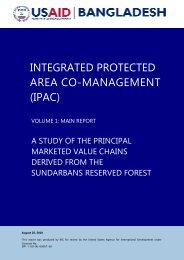Child Equity Atlas - BIDS
Child Equity Atlas - BIDS
Child Equity Atlas - BIDS
Create successful ePaper yourself
Turn your PDF publications into a flip-book with our unique Google optimized e-Paper software.
Population Distribution and Demographic Situation<br />
2.4 Population Under Five<br />
2.4.1 The population of children under five years<br />
reduced in the country from 13.0 to 10.5 per cent<br />
between the 2001 and 2011 Censuses. While the<br />
proportions of child population below five and<br />
below 18 have decreased between 2001 and 2011,<br />
the proportion of women of child bearing age (15-<br />
49 years) has however, marginally increased from<br />
51.0 per cent to 53.4 per cent during the same<br />
period. By districts, the highest and lowest with<br />
regard to proportion of children under five years<br />
varies from 14.4 per cent in Sunamganj to 8.3 per<br />
cent in Dhaka, presented in Table 2.3.<br />
Srl.<br />
Table 2.3: Proportion of children below<br />
5 years: Lowest and highest districts,<br />
Bangladesh 2011<br />
Lowest districts<br />
Highest districts<br />
District % District %<br />
1. Dhaka 8.3 Sunamganj 14.4<br />
2.<br />
Joypurhat,<br />
Rajshahi<br />
8.4 Brahmanbaria 13.7<br />
3. Khulna 8.5<br />
Cox’s Bazar,<br />
Habiganj<br />
13.3<br />
4.<br />
Meherpur,<br />
Satkhira<br />
8.6 Bandarban 13.2<br />
5. Naogaon 8.7 Kishoregonj 12.8<br />
Bangladesh: 10.5%<br />
2.5 Female Teenage Marriage<br />
2.5.1 The proportion of females aged 15-19<br />
years who are married declined by five percentage<br />
points in 10 years, from 37.5 per cent in 2001 to<br />
32.5 per cent in 2011. District-wise disparity in<br />
female teenage marriage population for 2001 is<br />
presented in Map 2.6. The 2011 data (Figure 2.2)<br />
shows the divisional prevalence of the female<br />
teenage married population in Bangladesh, which<br />
at district level varies from the highest at 53.7 per<br />
cent in Meherpur to the lowest of 13.5 per cent<br />
in Sylhet (Table 2.4). Nationally, almost one-third<br />
of the females in the country are married by their<br />
teens, a proportion that is one of the highest in<br />
the world. The female teenage married population<br />
significantly varied between different regions,<br />
from 42.8 per cent in Rajshahi Division to 15.9 per<br />
cent in Sylhet division (Figure 2.2).<br />
Table 2.4: Proportion of female teenage (15-<br />
19 years) married population: Low and high<br />
prevalence districts, Bangladesh 2011<br />
Low prevalence<br />
Srl. districts<br />
High prevalence districts<br />
District % District %<br />
1. Sylhet 13.5 Meherpur 53.7<br />
2. Maulvibazar 15.5 Chapai Nawabganj 48.0<br />
3. Sunamganj 16.4 Kurigram 47.8<br />
4. Chittagong 18.4 Chuadanga 46.7<br />
5. Habiganj 20.5 Bogra 46.4<br />
Bangladesh: 32.5%<br />
Female teenage married (%)<br />
Figure 2.2: Percentage of female teenage<br />
(15-19 years) married population by<br />
administrative divisions, Bangladesh 2011<br />
50.0<br />
40.0<br />
30.0<br />
20.0<br />
10.0<br />
0.0<br />
34.6<br />
Barisal<br />
25.2<br />
33.1<br />
Dhaka<br />
40. 8 42.8<br />
Khulna<br />
Rajshahi<br />
38.4<br />
Rangpur<br />
15.9<br />
Sylhet<br />
32.5<br />
2.5.2 The rates are higher in the western part<br />
of the country and lower in the eastern part,<br />
offering possible contexts to understand and deal<br />
with the social norms that underlie this practice,<br />
its variability and socioeconomic impact on girls<br />
and the economy. The district and upazila level<br />
variations (Maps 2.7 and 2.8) of teenage marriage<br />
depicted by the proportion of females married (at<br />
15-19 years) are presented to stimulate policy and<br />
Total<br />
21














